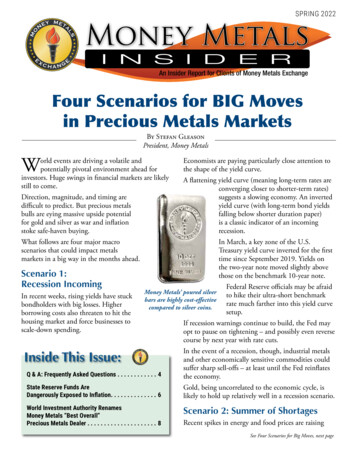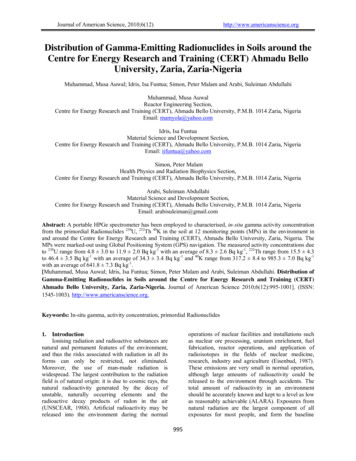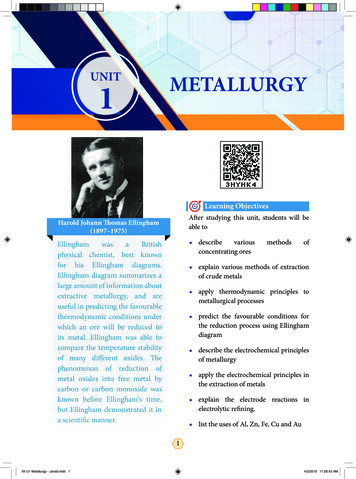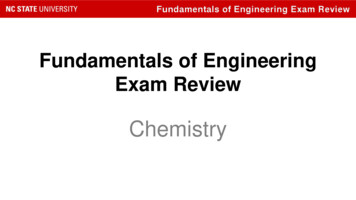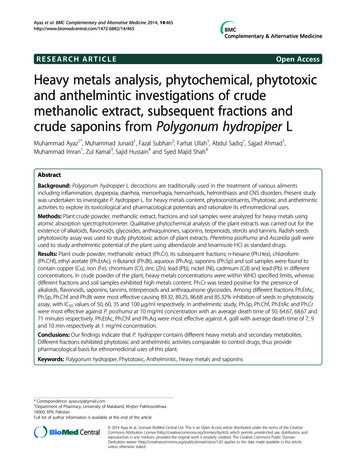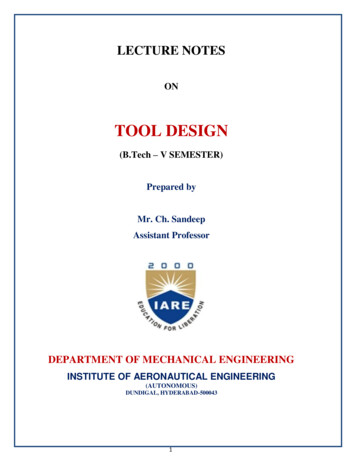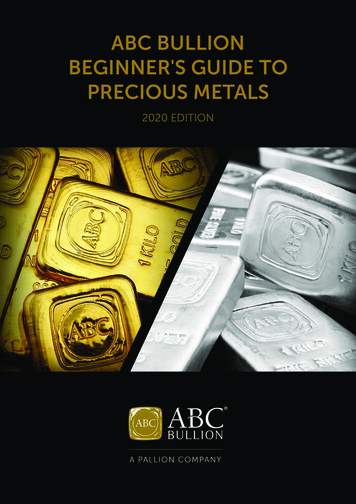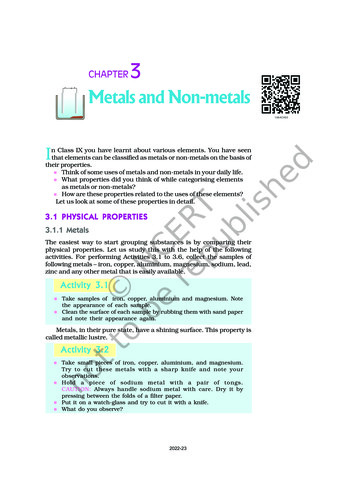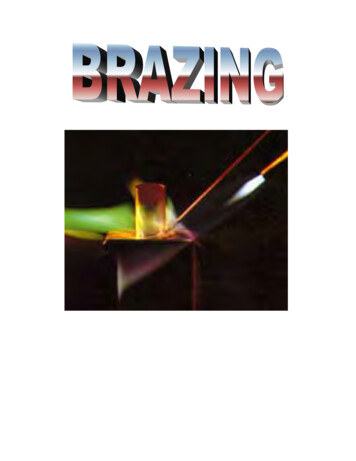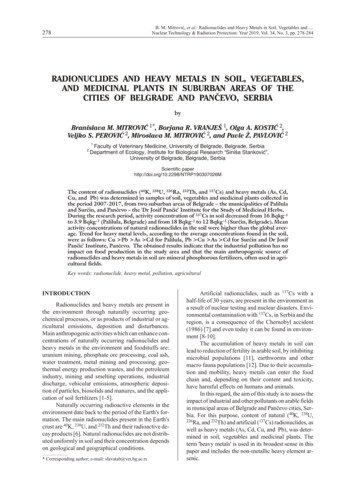
Transcription
B. M. Mitrovi}, et al.: Radionuclides and Heavy Metals in Soil, Vegetables and .Nuclear Technology & Radiation Protection: Year 2019, Vol. 34, No. 3, pp. 278-284278RADIONUCLIDES AND HEAVY METALS IN SOIL, VEGETABLES,AND MEDICINAL PLANTS IN SUBURBAN AREAS OF THECITIES OF BELGRADE AND PAN EVO, SERBIAbyBranislava M. MITROVI] 1*, Borjana R. VRANJEŠ 1, Olga A. KOSTI] 2,Veljko S. PEROVI] 2, Miroslava M. MITROVI] 2, and Pavle Ž. PAVLOVI] 212Faculty of Veterinary Medicine, University of Belgrade, Belgrade, SerbiaDepartment of Ecology, Institute for Biological Research “Siniša Stankovi}”,University of Belgrade, Belgrade, SerbiaScientific paperhttp://doi.org/10.2298/NTRP190307026MThe content of radionuclides (40K, 238U, 226Ra, 232Th, and 137Cs) and heavy metals (As, Cd,Cu, and Pb) was determined in samples of soil, vegetables and medicinal plants collected inthe period 2007-2017, from two suburban areas of Belgrade – the municipalities of Palilulaand Sur in, and Pan evo – the 'Dr Josif Pan i}' Institute for the Study of Medicinal Herbs.During the research period, activity concentration of 137Cs in soil decreased from 16 Bqkg–1to 3.9 Bqkg–1 (Palilula, Belgrade) and from 18 Bqkg–1 to 12 Bqkg–1 (Sur in, Belgrade). Meanactivity concentrations of natural radionuclides in the soil were higher than the global average. Trend for heavy metal levels, according to the average concentrations found in the soil,were as follows: Cu Pb As Cd for Palilula, Pb Cu As Cd for Sur in and Dr JosifPan i}' Institute, Pan evo. The obtained results indicate that the industrial pollution has noimpact on food production in the study area and that the main anthropogenic source ofradionuclides and heavy metals in soil are mineral phosphorous fertilizers, often used in agricultural fields.Key words: radionuclide, heavy metal, pollution, agriculturalINTRODUCTIONRadionuclides and heavy metals are present inthe environment through naturally occurring geochemical processes, or as products of industrial or agricultural emissions, deposition and disturbances.Main anthropogenic activities which can enhance concentrations of naturally occurring radionuclides andheavy metals in the environment and foodstuffs are:uranium mining, phosphate ore processing, coal ash,water treatment, metal mining and processing, geothermal energy production wastes, and the petroleumindustry, mining and smelting operations, industrialdischarge, vehicular emissions, atmospheric deposition of particles, biosolids and manures, and the application of soil fertilizers [1-5].Naturally occurring radioactive elements in theenvironment date back to the period of the Earth's formation. The main radionuclides present in the Earth'scrust are 40K, 238U, and 232Th and their radioactive decay products [6]. Natural radionuclides are not distributed uniformly in soil and their concentration dependson geological and geographical conditions.* Corresponding author; e-mail: slavatab@vet.bg.ac.rsArtificial radionuclides, such as 137Cs with ahalf-life of 30 years, are present in the environment asa result of nuclear testing and nuclear disasters. Environmental contamination with 137Cs, in Serbia and theregion, is a consequence of the Chernobyl accident(1986) [7] and even today it can be found in environment [8-10].The accumulation of heavy metals in soil canlead to reduction of fertility in arable soil, by inhibitingmicrobial populations [11], earthworms and othermacro fauna populations [12]. Due to their accumulation and mobility, heavy metals can enter the foodchain and, depending on their content and toxicity,have harmful effects on humans and animals.In this regard, the aim of this study is to assess theimpact of industrial and other pollutants on arable fieldsin municipal areas of Belgrade and Pan evo cities, Serbia. For this purpose, content of natural (40K, 238U,226Ra, and 232Th) and artificial (137Cs) radionuclides, aswell as heavy metals (As, Cd, Cu, and Pb), was determined in soil, vegetables and medicinal plants. Theterm 'heavy metals' is used in its broadest sense in thispaper and includes the non-metallic heavy element arsenic.
B. M. Mitrovi}, et al.: Radionuclides and Heavy Metals in Soil, Vegetables and .Nuclear Technology & Radiation Protection: Year 2019, Vol. 34, No. 3, pp. 278-284MATERIAL AND METHODSFirst sampling site was the municipality of Palilulain Belgrade (45 06' N, 20 23' E), located on the left bankof Danube river. Today it is one of the most fertile areas inSerbia with alluvial Fluvisol soil [13]. Around 15 kmaway is the city of Pan evo, where the largest petrochemical producers in Serbia – 'Pan evo'oil refinery, with total installed processing capacity of about 4.8 million tonsa year, and 'HIP-Petrohemija' – are located, making it themain industrial hot spots in Serbia.Second sampling site was in the productionfields of the 'Dr Josif Pan i}' Institute for the Studyof Medicinal Herbs in Pan evo (44 53' N, 20 40' E)located 4.5 km away from Pan evo city center and19.6 km away from Belgrade city center, which ischaracterized by Chernozem soil [13]. Municipality ofSur?in in Belgrade (44 47' N, 20 16' E), was used as acontrol area, because there are no industrial sources ofenvironmental pollution. This sampling site is alsocharacterized by Chernozem soil [13].Between the years 2007 and 2017, samples ofcultivated soil and vegetables were collected fromPalilula (sampling points: Ov a, Bor a, and Dunavac)and Sur in (sampling points: Jakovo and Boj in forest), both areas with intensive agricultural production,and from 'Dr Josif Pan i}' Institute in Pan evo, fig. 1.For radionuclides (40K, 238U, 226Ra, 232Th, and137Cs) determination in soil and medicinal plants, weused gamma ray spectrometry on a High Purity Germanium detector (ORTEC) with a relative efficiency of30% and energy resolution of 1.85 keV (at 1332.5 keV,from 60Co). Samples of soil (cultivated) with a mass of3-5 kg were collected from a depth of 0-20 cm, homogenized, dried at 105 C, and stored in 1l Marinelli beakers. Samples of medicinal plants were dried at 105 C,homogenized and measured into 1l Marinelli beakers.Samples of medicinal plants were dried at 105 C, ho-279mogenized and measured into 1l Marinelli beakers. Homogenized samples were sealed tightly and kept for 40days to ensure that equilibrium between 226Ra and itsshort-lived decay products was reached. We used commercially available standards with mixed radionuclidesfor calibration:– 241Am and 152Eu, dispersed in silicone resin in aMarinelli beaker, density (0.182 0.05) gcm–3,volume 1l and– 241Am, 109Cd, 139Ce, 57Co, 60Co, 137Cs, 113Sn, 85Sr,and 88Y, dispersed in silicone resin in a Marinellibeaker, density (1.22 0.01) gcm–3, volume 1l.The first calibration standard was used for plantmeasurements, and the second for soil measurements.The counting time for the samples, as well as for thebackground, was 60000 s.For heavy metal analysis, soil samples wereair-dried and passed through a 0.2 mm stainless steelsieve, including blank sieving prior to chemical analysis.Plant samples were dried to a constant weight at 65 ºCand ground in a laboratory mill (Polymix, KinematicaAG, screen size 2.0 mm). Sample mineralization (soil0.5 g; plant 0.4 g) was conducted through wet digestionin a microwave (CEM, Microwave 39 MDS- 2000), inadvanced composite vessels, by using a 3:1 mixture ofnitric acid (HNO3, 65 %) and hydrogen peroxide (H2O2,30 %). Total concentrations of As, Cd, Cu, Ni, Pb, and Znwere determined through inductively coupled plasmaspectrometry (ICP-OES, Spectro Genesis). In order tocheck the accuracy and determine the uncertainty of themeasured concentrations of heavy metals, standard reference samples (standard reference soil-ERM-CC141(loam soil) and plant material-BCR-100 (beech leaves)obtained from the IRMM (Institute for Reference Materials and Measurements, Geel, Belgium) and certified bythe EC-JRC (European Commission – Joint ResearchCentre), were used. Measurements were done in 5 replicates.Figure 1. Study areas with the designated sampling points
B. M. Mitrovi}, et al.: Radionuclides and Heavy Metals in Soil, Vegetables and .Nuclear Technology & Radiation Protection: Year 2019, Vol. 34, No. 3, pp. 278-284280Radiation hazard parametersCalculation of the external hazard indexIn order to assess the radiation hazard, the following parameters were calculated: absorbed doserate D& (nGyh–1), annual effective dose EDE (mSva–1)and external hazard index Hex.The external hazard index, Hex, is defined by thefollowing equation [15]Hex CRa/370 CTh/259 CK/4810(3)Calculation of the absorbed dose rateIf Hex is less than one, the radiation hazard is insignificant. Hex value equal to one corresponds to the upperlimit of radium equivalent activity (370 Bqkg–1).The mean activity concentrations of 236Ra,and 40K were converted into doses using conversion factors. The calculations were performed according to the following eq. [14]RESULTS AND DISCCUSION232Th,D& ( nGyh -1 ) 0.462C Ra 0.604 C Th 0.042C K (1)In the eq. (1), it is assumed that all the decayproducts of 226Ra and 232Th are in equilibrium withtheir precursors.Calculation of the annual effective doseIn order to estimate the annual effective dose, eq.(2), the conversion coefficient from the absorbed dosein the air to the effective dose must be considered.Thus, from the dose rate data obtained from the concentration values of natural radionuclides in the soiland by adopting a conversion factor of 0.7 SvGy–1 [14]and assuming that the people in Serbia spend an average of 20 % of their time outdoors, the annual effectivedose can be calculated asAEDE ( mSv ) D& ( nGyh -1 ) 24( hd –1 ) 365(d ) 0.7( SvGy -1 ) 0.2(2)The global average activity concentrations of natural radionuclides present in soil [14] are 400 Bqkg–1 for40K, 35 Bqkg–1 for 238U and 226Ra, and 30 Bqkg–1for232Th. In the studied soils from municipalities Palilula andSur in, mean activity concentrations of 40K (675 Bqkg–1),238U (39 Bqkg–1), 226Ra (38 Bqkg–1) and 232Th (43Bqkg–1) were above the world average, as a consequenceof geological characteristics, tab. 1. Higher activity concentration of 40K was detected in soil from the 'Dr JosifPan i}' Institute, Pan evo, tab. 1, probably due to the useof potassium mineral fertilizers [16]. Mineral fertilizersmay contain high activity concentrations of naturalradionuclides like 238U, 232Th, and 40K and heavy metalslike Pb, Cd, and Cu [17] and can be an anthropogenicsource of these elements for the environment. Researchconducted on arable and non-arable soils in suburban regions of Belgrade showed that mineral fertilizers did notcause an increase in natural radioactivity in the studiedsoils [18]. In contrast to these findings, in Switzerland, dueto the use of mineral fertilizers since 1985, uranium concentrations in arable soils have increased significantly[17]. According to Serbian legislation (Official GazetteRS 97/13) [19], the permissible levels of 238U and 226Ra inTable 1. Activity concentrations of radionuclides (40K, 238U, 226Ra, 232Th, 137Cs) and radiation hazard parameters in arablesoil collected in Belgrade municipalities and Pan evo (the 'Dr Josif Pan i}' Institute)Sample238KU–1[Bqkg ]226Th137CsHexArable soilArable soilSur in, Belgrade, 2007-2008642 17 40 9 44 4 41 418 1720.090.41Garden soilArable soilSur in, Belgrade, 2013-2014531 23 35 5 33 3 35 115 1623 15 51 10 39 3 42 116 159700.070.090.330.40Arable soilSur in, Belgrade, 2016-2017564 25 33 8 35 3 37 312 1620.080.35“Dr Josif Pan i}” Institute, Pan evo, 2016-2017Soil (under Common fennel) 839 39 39 9 41 4 52 48612 1Soil (under Horseradish) 822 35 30 8 34 3 50 48014 1Soil under (Lemon balm) 801 35 40 9 38 3 47 48015 20.100.100.100.490.460.45Mean standard deviationRa232Absorbed dose rate Annual effective dose[nGyh–1][mSv]Palilula, Belgrade, 2007-2008700.09608 181 48 9 43 4 40 416 1Palilula, Belgrade, 2016-2017650.08619 19 34 4 35 4 37 3 3.9 0.2Arable soil1400.400.37
B. M. Mitrovi}, et al.: Radionuclides and Heavy Metals in Soil, Vegetables and .Nuclear Technology & Radiation Protection: Year 2019, Vol. 34, No. 3, pp. 278-284mineral phosphorus fertilizers are 1600 Bqkg–1 (3200Bqkg–1 for raw materials) and 1000 Bqkg–1, respectively,which reduce input of radionuclides into the environment.Radiocesium-137 was detected in soil, but during the research period, its activity concentration decreased from 16 Bqkg–1 to 3.9 Bqkg–1 (Palilula) andfrom 18 Bqkg–1 to 12 Bqkg–1 (Sur in), as a consequence of its half-life.All the locations exhibited an absorbed dose ratehigher than the world average of 58 nGyh–1[6], as a result of the particularly high activity concentrations ofnatural radionuclides in the soil, which, in turn, increased the terrestrial gamma dose rate, tab. 1. Themean value of the absorbed dose rate was 71 nGyh–1.Similar results were obtained in Bulgaria and Italy,where the mean values of the absorbed dose rate were70 nGyh–1 and 74 nGyh–1, respectively [6]. Obtainedexternal hazard index values were mostly less thanone, tab. 1, which is the limit recommended by ICRP[20], meaning that the research area is safe for humansto carry out their activities.Absorption of radionuclides via roots and theiraccumulation in plants depends on many abiotic andbiotic factors, such as soil type, climatic conditions,plant species, moisture regime, stand composition and281age. In medicinal plants from "Dr Josif Pan i}"Institute, Pan evo, both natural (226Ra and 232Th) andartificial (137Cs) radionuclides were detected in medicinal plants, tab. 2. The average activity concentration of 137Cs was 1.7 Bqkg–1, with the highest contentdetected in horseradish (3.9 Bqkg–1), tab. 2.Highly reactive and often toxic at low concentrations, heavy metals may enter soils and groundwater,bioaccumulate in food webs, and adversely affectbiota including humans. Vegetable crop plants have ahigh ability to accumulate metals from soil, which maypose as a risks to human health when they are grownon or near contaminated soils and consumed; thus, theaccumulation of heavy metals in the edible parts ofvegetables represents a direct pathway for their incorporation into the human food chain [21]. Average concentrations of As, Cd, Cu, and Pb (mgkg–1) in soil andvegetables, from the sampling sites, are shown in tab. 3(municipalities of Palilula and Sur in, Belgrade) andtab. 4 ('Dr Josif Pan i}' Institute, Pan evo). Trend ofheavy metal levels, according to the average concentrations found in the studied soil, was as follows: Cu Pb As Cd for Palilula, Pb Cu As Cd for Sur inand 'Dr Josif Pan i}' Institute, Pan evo.Table 2. Specific activity concentrations of 40K, 226Ra, 232Th, and 137Cs in medicinal plant samples collected at the 'Dr JosifPan i}' Institute, Pan evo [Bqkg–1]Sample/radionuclideCommon fennelHorseradishLemon balm140K969 391866 26449 22226Ra MDA2 MDA4.4 0.3232Th MDA11 13.9 0.5137Cs0.5 0.13.9 0.30.6 0.1Mean standard deviation [mgkg–1]; 2MDA: minimum detectible activityTable 3. Metal content (As, Cd, Cu, and Pb) in soil and vegetables collected from the municipalities of Palilula and Sur in,BelgradeSample/heavy metalCultivated soil – arable soilCarrotsPotatoesOnionsCultivated soil – garden soilCultivated soil – arable soilCarrotsPotatoesOnionsCabbageCultivated soil – arable soilCarrotsPotatoesOnionsCabbage1Mean standard deviation [mgkg–1]AsCdPalilula, Belgrade, 2016-20173.38 0.9411.95 0.16 MDA MDA MDA MDA MDA MDASur in, Belgrade 2013-2014 MDA5.55 0.78 MDA7.09 1.140.25 0.080.02 0.020.74 0.140.02 0.01 MDA0.50 0.19 MDA0.84 0.182016-20176.61 2.791.63 0.42 MDA MDA MDA MDA MDA MDA MDA MDACuPb37.0 0.30.58 0.030.41 0.030.22 0.0534.6 6.1 MDA MDA MDA30.6 0.634.1 0.53.41 0.673.19 0.261.53 0.191.14 0.0343.8 5.959.7 2.60.33 0.030.49 0.110.21 0.04 MDA32.0 3.40.58 0.030.17 0.010.44 0.060.21 0.0436.7 11.70.35 0.31 MDA0.39 0.0 MDA
B. M. Mitrovi}, et al.: Radionuclides and Heavy Metals in Soil, Vegetables and .Nuclear Technology & Radiation Protection: Year 2019, Vol. 34, No. 3, pp. 278-284282Table 4. As, Cd, Cu, and Pb concentrations in soil and medicinal plants, and the plant concentration factor (PCF),at the “Dr Josif Pan i}” Institute, Pan evoSample/heavy metalSoilPlant (common fennel)PCFSoilPlant root (Horseradish)PCF rootPlant leaves (Horseradish)PCF leavesSoilPlant (Lemon balm)PCF1As [mgkg–1]8.41 0.211 MDA/10.66 0.181.95 0.580.181.66 0.290.1610.76 1.35 MDA/Cd [mgkg–1]2.75 0.77 MDA/3.50 0.56 MDA/ MDA/3.75 0.47 MDA/Cu [mgkg–1]29.0 0.18.66 0.330.329.5 0.11.89 0.470.062.94 0.170.128.0 0.511.59 0.390.41Pb [mgkg–1]32.7 0.9 MDA/42.8 0.8 MDA/ MDA/46.9 4.8 MDA/Mean standard deviation [mgkg–1]Table 5. Reference values for concentrations of heavymetals in soil [mgkg–1]ElementAsCdCuPbOff. Gaz. RS 23/94) [22] EEC/86/278) [27]25–31-310050-14010050-300Mean concentrations of heavy metals in soilfrom Palilula, did not exceed maximum permissiblelevels prescribed by Serbian regulations [22] andCouncil Directive [23]. However, content of Cd in soilfrom 'Dr Josif Pan i}' Institute, Pan evo, exceeded thereference values, tab. 5.Arsenic was detected in vegetables collectedfrom Sur in in 2013-2014, with the average concentration being 0.58 mgkg–1 (0.25-0.84 mgkg–1), tab. 3,pointing to the effects of intensive agricultural production, i. e. the use of herbicides and insecticides [24], aswell as the use of phosphate fertilizers containing As[25]. However, research conducted in 2016-2017showed that arsenic was not present in the vegetablesat this location.Anthropogenic source of Cd is industrial discharge from the metallurgical and chemical industries,combined with developed agricultural production, including the use of phosphate fertilizers, which are oneof the most ubiquitous sources of Cd contamination inagricultural soils throughout the world [26]. NormalCd content in soils is between 0.2-1.1 mgkg–1 [26].Cadmium can enter the food chain via plants, withvegetables being the main source of Cd for humans[26]. Phosphate fertilizers and sewage sludge are themain source of Cd input in soils [17]. In Switzerland,mean Cd concentrations were 58 % higher in arabletop soil than in arable subsoil, which points to the significance of Cd input in arable soils [17]. The presenceof Cd was noted only in carrot and potato samples collected from Sur in in 2013-2014, tab. 3.Copper was found in all investigated soil, vegetables and medicinal samples, tabs. 3 and 4. In soil, coppercontent is closely associated with soil texture and severalother soil parameters, in particular soil pH and SOM,which control its distribution and behavior [26]. Cu content in plant tissue depends on its levels in the soil, butalso on the characteristics of the plants themselves [26].In the studied vegetables, tab. 3, Cu content fell within anappropriate range for food consumption in the USA,which amounts to 0.1-3.2 mgkg–1 for vegetables, as wellas within a normal range for the optimal functioning ofplants [28]. National regulations do not prescribe a normfor levels of this element in foodstuffs of plant and animal origin.Lead is a metal found in the earth's crust and hasbeen mobilized in the environment by recent anthropological activities. In our study, lead concentrationsranged from 32.70-59.70 mgkg–1 with a maximumlevel found in Sur in, tabs. 3 and 4. However, in vegetables, tab. 3, Pb levels were within the range of reference values (3 mgkg–1), while in medicinal plants, tab.4, Pb was not detected.Plant concentration factor (PCF), tab. 4, variedwith heavy metal type and plant species, and dependedon the metal concentrations in soil and each plant'sheavy metal uptake capacity. The PCF for Cd and Pbwas not established.CONCLUSIONResearch in Belgrade and Pan evo suburban areas was conducted with the aim of determining thecontent of radionuclides and heavy metals in the environment. Sampling sites were selected on the groundsthat they have significant areas of agricultural land forproduction of food for residents of Belgrade and arelocated in the vicinity of a large industrial area dominated by oil refinery and petrochemical industry in thecity of Pan evo. Results obtained in this long-termstudy indicate that industrial pollution has no impacton food production in the study area and that the mainanthropogenic source of radionuclides and heavy metals in soil are probably mineral phosphorous fertilizers, often used in agricultural fields. It was also foundthat all of the studied samples of vegetables are safe for
B. M. Mitrovi}, et al.: Radionuclides and Heavy Metals in Soil, Vegetables and .Nuclear Technology & Radiation Protection: Year 2019, Vol. 34, No. 3, pp. 278-284both human and animal consumption. These resultsemphasize the importance of environmental monitoring, especially in those localities where there is a potential risk of anthropogenic contamination with different pollutants.[9][10][11]ACKNOWLEDGMENT[12]This paper is a part of the research done within theprojects financed by the City of Belgrade, Secretariatfor Environmental Protection (V-01 401.1-19/16) andby the Ministry of Education, Science and Technological Development of the Republic of Serbia (TR31003and 173018) (2011-2018).AUTHORS' CONTRIBUTIONSB. M. Mitrovi}, B. R. Vranješ, O. A. Kosti} andM. M. Mitrovi} collected samples. B. M. Mitrovi}, B.R. Vranješ, V. S. Perovi}, and O. A. Kosti} analyzedthe samples. B. M. Mitrovi}, P. Ž. Pavlovi}, O. A.Kosti}, and M. M. Mitrovi} interpreted the results anddiscussed them in reference to the literature data. Allthe authors contributed to the manuscript preparationand approved its final version.REFERENCES[1][2][3][4][5][6][7][8]***, U.S. EPA: Evaluation of EPA's Guidelines forTechnologically Enhanced Naturally Occurring Radioactive Materials (TENORM), Evaluation of EPA'sGuidelines on Technologically Enhanced NaturallyOccurring Radioactive Materials (TENORM). EPA402-R-00-01, United Stated, 2000Czarnecki, S., During, R. A., Influence of Long-TermMineral Fertilization on Metal Contents and Properties of Soil Samples Taken from Different Locationsin Hesse, Germany, Soil 1 (2015), 1, pp. 23-33Wuana, R. A., Okieimen, F. E., Heavy Metals in Contaminated Soils: A Review of Sources, Chemistry,Risks and Best Available Strategies for Remediation,ISRN Ecol. 2011, (2011), ID402647Hamurcu, M., et al., Mineral and Heavy Metal Levelsof Some Fruits Grown at the Roadsides, Food Chem.Toxicol., 48 (2010), 6, pp. 1767-1770Karatasli, M., Radionuclide and Heavy Metal Contentin the Table Olive (Olea Europaea l.) from the Mediterranean Region of Turkey, Nucl Technol Radiat, 33(2018), 4, pp. 386-394***, UNSCEAR: Sources and Effects of Ionizing Radiation, United Nation, Vol. I, annex B. New York,2008Popovi}, D., Spasi}-Joki}, V., Consequences of theChernobyl Disaster in the Region of the Republic ofSerbia (in Serbian), Vojnosanitetski pregled, 63(2006), 5, pp. 481-487Vitorovi}, G. S., et al., Radioactive Contamination ofFood Chain Around Coal Mine and Coal-Fired PowerStations, Nucl Technol Radiat, 27 (2012), 4, [23][24][25][26][27]283Mitrovi}, B.,et al., Natural and Anthropogenic Radioactivity in the Environment of Kopaonik Mountain, Serbia, Environ. Pollut., 215 (2016), Aug., pp. 273-279Džolji}, J., et al., Natural and Artificial Radioactivityin Some Protected Areas of South East Europe, NuclTechnol Radiat, 32 (2017), 4, pp. 334-341Olaniran, A. O., et al., Bioavailability of Heavy Metalsin Soil: Impact on Microbial Biodegradation of Organic Compounds and Possible Improvement Strategies, Int. J. Mol. Sci., 14 (2013), 5, pp. 10197-10228Nahmani, J., Lavelle, P., Effects of Heavy Metal Pollution on Soil Macrofauna in Grassland of NorthernFrance, European Journal of Soil Biology, 38 (2002),3-4, pp. 297-300Pavlovi}, P., et al., The Soils of Serbia, World SoilsBook Series (Ed A. E. Hartemink), The Netherlands,2017***, UNSCEAR: Report to the General Assembly,with Scientific Annexes. Sources and Effects of Ionizing Radiation, Annex B. United Nations, New York,2000Beretka, J., Matthew, P. J., Natural Radioactivity ofAustralian Building Materials, Industrial Wastes andBy-Products, Health Physics, 48 (1985), 1, pp. 87-95Uosif, M. A. M., et al., Natural Radioactivity Levelsand Radiological Hazards Indices of Chemical Fertilizers Commonly Used in Upper Egypt, J. Radiat. Res.Appl. Sci., 7 (2014), 4, pp. 430-437Bigalke, M., et al., Accumulation of Cadmium andUranium in Arable Soils in Switzerland, Environ.Pollut., 221 (2017), Feb., pp. 85-93Mitrovi}, B., et al., Natural Radionuclides in MineralFertilizers and Farmland (in Serbian), Vet Glas, 67(2013), 6-7, pp. 359-367***, Official Gazette Republic of Serbia, 97/13,Rulebook on Limits of Radionuclides Content inDrinking Water, Foodstuffs, Feeding Stuffs, Medicines, Products for General Use, Construction Materials and Other Goods That are Put on Market, OfficialBulletin of Republic of Serbia, 2013***, ICRP: Protection of the Public in Situations ofProlonged Radiation Exposure, ICRP Publication 82,2000Florijin, P. J., Van Beusichem M. L,. Uptake and Distribution of Cd in Maize Inbred Line, Plant Soil, 150(1993), 1, pp. 25-32***, Official Gazette Republic of Serbia, 23/1994,Regulation on Permitted Quantities of Dangerous andHarmful Materials in Soil and Water for Irrigation andMethods of their Examination, Official Bulletin ofRepublic of Serbia, 1994***, EEC/86/278: Council Directive 86/278/EEC onthe Protection of the Environment, and in Particular ofthe Soil, When Sewage Sludge is Used in Agriculture,Eur-Lex, 1986Bencko, V., Yan Li Foong, F., The History of Arsenical Pesticides and Health Risks Related to the Use ofAgent Blue, Ann Agric Environ Med, 24 (2017), 2, pp.312-316Jayasumana, C., et al., Phosphate Fertilizer is a MainSource of Arsenic in Areas Affected with ChronicKidney Disease of Unknown Etiology in Sri Lanka,Springerplus, 4 (2015), 90Kabata-Pendias, A., Pendias, H., Trace Elements inSoils and Plants, CRC Press, Boca Raton, Fla., USA,2001***, EC/1881/2006: Commission Regulation onMaximum Levels of Cadmium in Foodstuffs: TheAnnex to Regulation (EC) No 1881/2006. Eur-Lex,2006
284B. M. Mitrovi}, et al.: Radionuclides and Heavy Metals in Soil, Vegetables and .Nuclear Technology & Radiation Protection: Year 2019, Vol. 34, No. 3, pp. 278-284[28] Ensminger, A. H., et al., The Concise Encyclopaediaof Foods and Nutrition, 2nd ed. CRC Press, BocaRaton, Fla., USA, 1995Paper recived on March 7, 2019Accepted on July 19, 2019Branislava M. MITROVI], Borjana R. VRAWE[, Olga A. KOSTI],Veqko S. PEROVI], Miroslava M. MITROVI], Pavle @. PAVLOVI]RADIONUKLIDI I TE[KI METALI U ZEMQI[TU,POVR]U I LEKOVITOM BIQU POREKLOM IZ PRIGRADSKIHOP[TINA BEOGRADA I PAN EVA, SRBIJAU zemqi{tu, povr}u i lekovitom biqu sakupqanim tokom 2007-2017 godine na podru juprigradskih naseqa Beograda (op{tine Palilula i Sur in) i Pan eva (Institut za prou avawelekovitog biqa “Dr Josif Pan i}”), odre ivan je sadr aj radionuklida (40K, 238U, 226Ra, 232Th,137Cs)i te{kih metala (As, Cd, Cu, i Pb). Rezultati su pokazali da se tokom perioda istra ivawaspecifi na aktivnost 137Cs u zemqi{tu smawila sa 16 Bqkg–1 na 3.9 Bqkg–1 (Palilula, Beograd) i sa18 Bqkg–1 na 12 Bqkg–1 (Sur in, Beograd).Na podru ju op{tine Palilula u zemqi{tu je bilo najvi{e Cu, a zatim Pb As Cd, dok je naispitivanim lokalitetima op{tine Sur in i Instituta za prou avawe lekovitog biqa “Dr JosifPan i}” koncentracija Pb bila najve}a, a zatim Cu As Cd. Dobijeni rezultati su pokazali dablizina industrijskih postrojewa nema negativan uticaj na poqoprivrednu proizvodwu naispitivanim lokalitetima i da su glavni izovr kontaminacije zemqi{ta i biqakaradionuklidima i te{kim metalima fosfatna mineralna ubriva.Kqu ne re i: radionuklid, te{ki metal, zaga ewe, poqoprivredna proizvodwa
e nize d, drie d at 105 C, a nd store d in 1l Mar inel li beak - ers. Sam ples of me dic i nal plants were dried at 105 C, ho mog e nized and mea sured into 1l Marinelli beak ers. Samples of me dic i nal plants were dried at 105 C, ho - mog e nize d and m ea sured i nto 1l Mar inel li beak ers. Ho -
